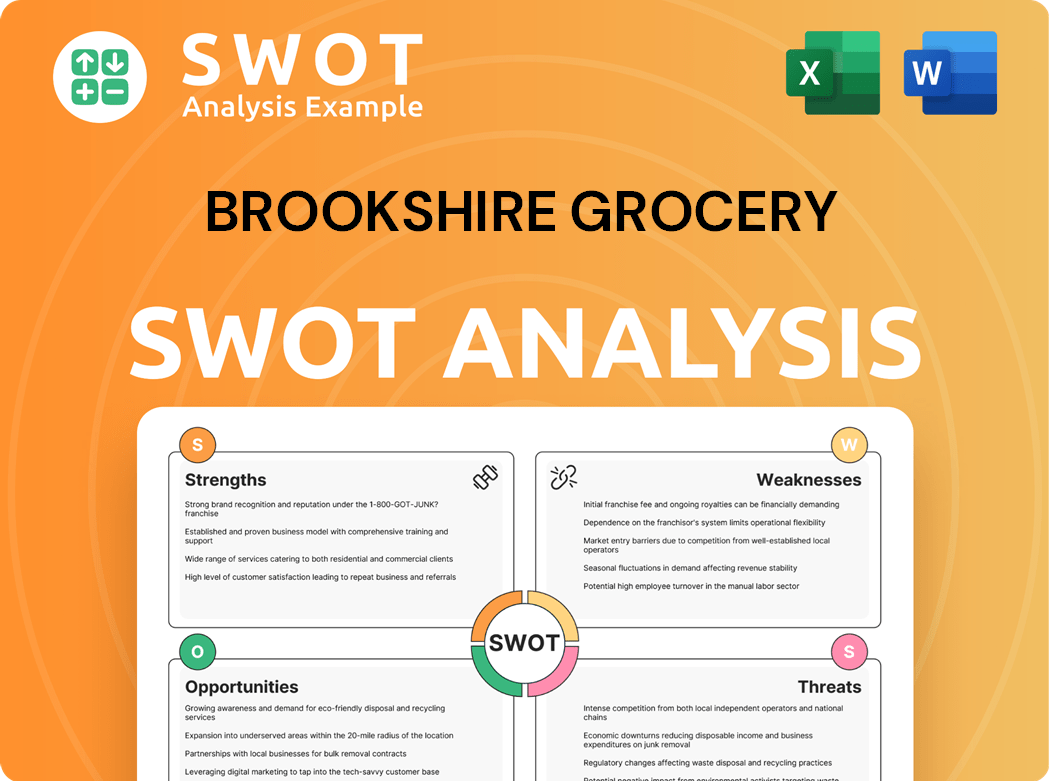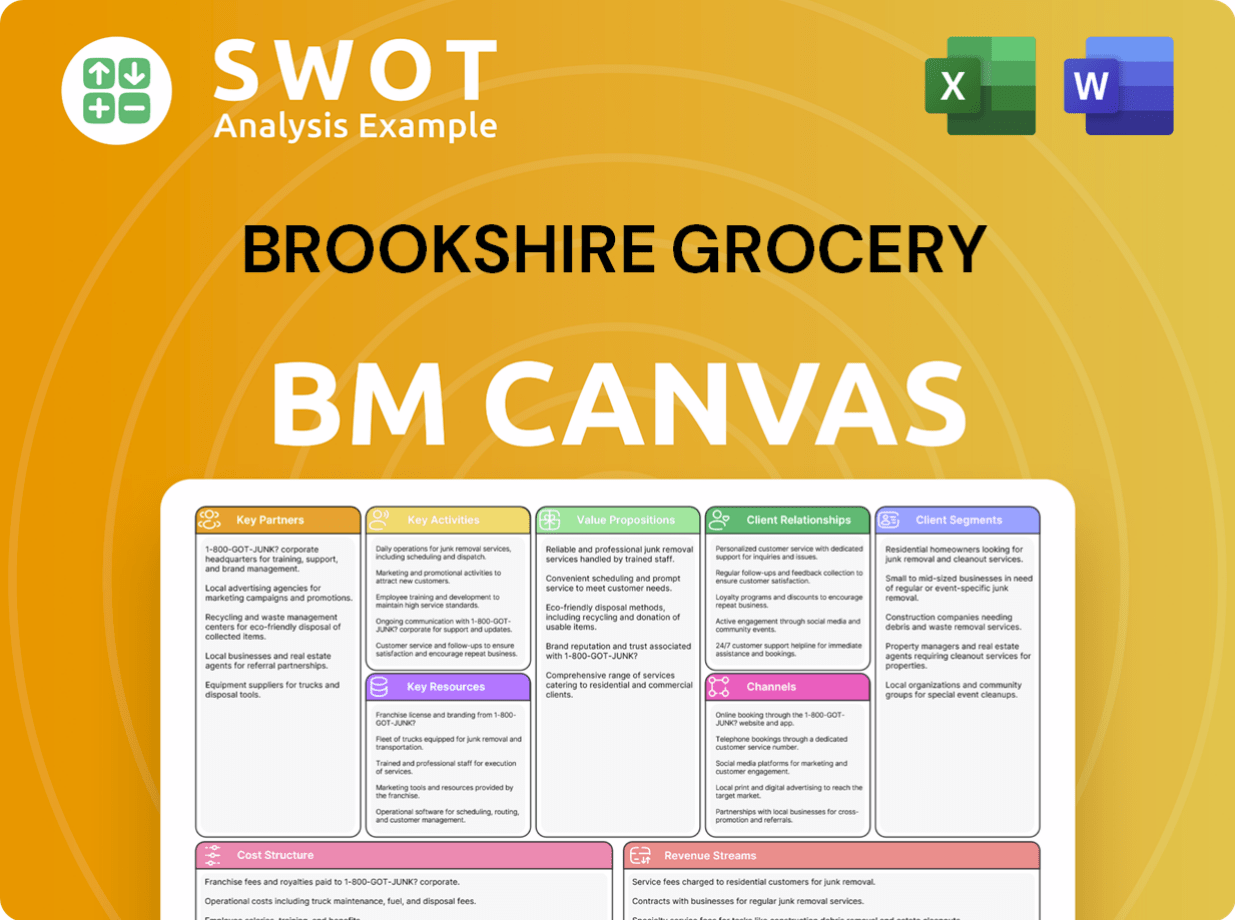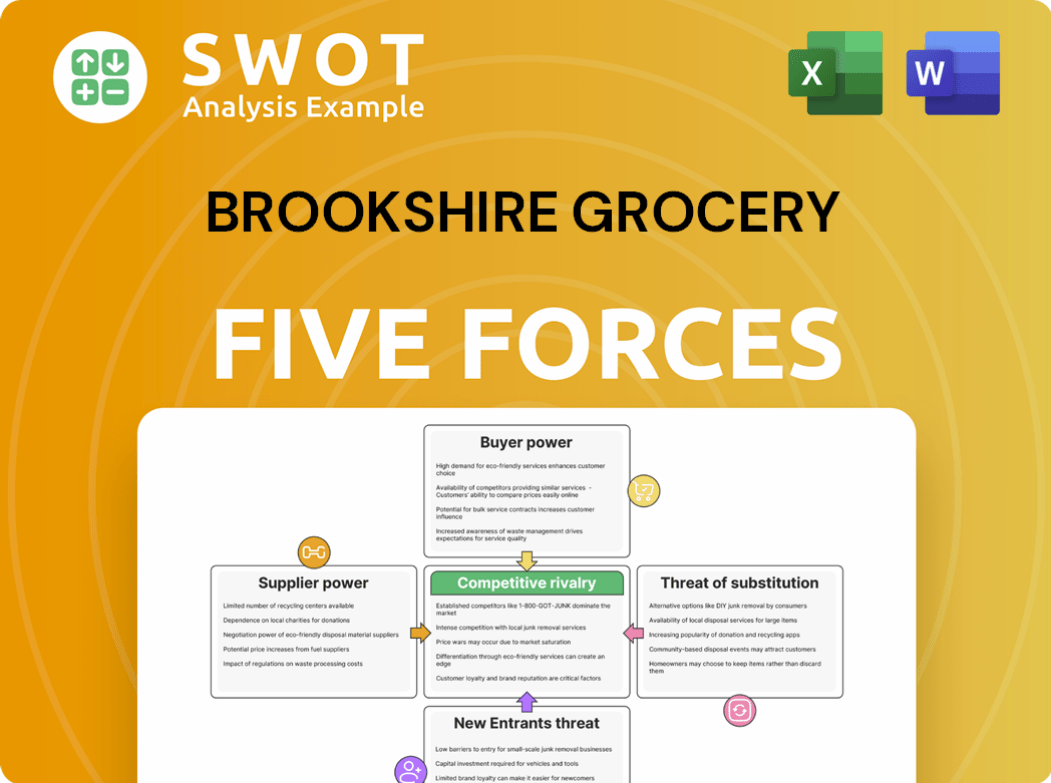Brookshire Grocery Bundle
How Does Brookshire Grocery Company Thrive in a Competitive Market?
Brookshire Grocery Company (BGC) has carved a significant niche in the grocery store landscape of Texas, Louisiana, and Arkansas. From its humble beginnings in 1928, BGC has evolved into a multi-banner retail powerhouse, including Brookshire's and Super 1 Foods. This strategic diversification allows the company to cater to a wide range of customer preferences and market segments.

This exploration into Brookshire Grocery Company will dissect its operational strategies, revenue streams, and competitive positioning within the retail sector. Discover how Brookshire's, a key player in the supermarket industry, has adapted to the changing demands of consumers. For deeper insights into BGC's strategic advantages, consider the Brookshire Grocery SWOT Analysis to understand its strengths, weaknesses, opportunities, and threats.
What Are the Key Operations Driving Brookshire Grocery’s Success?
The core operations of the Brookshire Grocery Company (BGC) revolve around its network of grocery stores, offering a wide range of products and services designed to meet the daily needs of customers across Texas, Louisiana, and Arkansas. As a grocery store, BGC focuses on providing fresh produce, high-quality meats, bakery items, dairy products, frozen foods, and a comprehensive selection of household goods. Beyond groceries, BGC enhances its value proposition by offering pharmacy services and operating fuel centers at select locations, boosting convenience for customers.
The value proposition of Brookshire's centers on delivering a personalized shopping experience. They focus on fresh, high-quality products, convenient access to essential services, and community engagement. This approach differentiates Brookshire's from larger, more standardized national competitors. They aim to cater to specific regional consumer preferences.
Operational processes emphasize efficiency and freshness. Sourcing involves direct relationships with local and regional producers, supplementing national distribution channels. Logistics ensure timely delivery of fresh and perishable items to all store locations. In-store operations focus on customer service, product presentation, and efficient checkout processes, often using technology for inventory management and customer loyalty programs.
BGC offers a broad selection of products, including fresh produce, meats, bakery items, dairy, frozen foods, and household goods. They also provide pharmacy services and fuel centers at select locations. The company's offerings are tailored to meet the diverse needs of its customers, ensuring a one-stop shopping experience.
BGC maintains operational efficiency through a sophisticated distribution network, ensuring timely delivery of fresh and perishable items. In-store operations are streamlined, focusing on customer service and efficient checkout processes. Technology is utilized for inventory management and customer loyalty programs.
The company focuses on providing a personalized shopping experience, emphasizing fresh, high-quality products and convenient services. Community engagement is a key element, differentiating BGC from larger competitors. This localized approach helps build customer loyalty.
BGC actively engages with local communities, supporting local economies through sourcing and community programs. This commitment strengthens customer relationships and reinforces the company's brand. Community involvement is a core part of their strategy.
BGC's operations are built on efficient sourcing, robust logistics, and a customer-focused in-store experience. They aim to cater to specific regional consumer preferences. This approach ensures fresh products and convenient services.
- Direct sourcing from local and regional producers.
- Sophisticated distribution network for timely deliveries.
- Emphasis on customer service and efficient checkout.
- Use of technology for inventory and loyalty programs.
Brookshire Grocery SWOT Analysis
- Complete SWOT Breakdown
- Fully Customizable
- Editable in Excel & Word
- Professional Formatting
- Investor-Ready Format

How Does Brookshire Grocery Make Money?
The primary revenue stream for Brookshire Grocery Company (BGC) is derived from direct product sales within its supermarket banners. This involves the sale of groceries, including fresh produce, meat, dairy, bakery items, and general merchandise. As a privately held company, specific financial figures for 2024 or 2025 are not publicly available.
BGC's business model relies on consistent sales driven by consumer demand for everyday necessities. The grocery retail industry typically experiences stable sales, reflecting the essential nature of its products. The company strategically diversifies its revenue sources to enhance profitability and customer value.
Beyond core grocery sales, BGC utilizes several additional revenue streams. These include pharmacy services, fuel centers, private-label brands, and targeted promotions. These strategies enhance customer convenience and increase overall revenue.
BGC employs various strategies to boost revenue and customer engagement. These strategies complement the core grocery sales and enhance the overall customer experience. The company's focus on these additional revenue streams illustrates its commitment to providing value and convenience.
- Pharmacy Services: Many locations offer pharmacy services, contributing through prescription fulfillment and over-the-counter medication sales.
- Fuel Centers: Select stores include fuel centers, which generate revenue and often integrate with loyalty programs.
- Private-Label Brands: BGC utilizes private-label brands, which typically offer higher profit margins compared to national brands.
- Promotions and Loyalty Programs: Targeted promotions and loyalty programs encourage repeat business and increase basket size. For example, the company's rewards program offers exclusive deals and discounts to frequent shoppers.
Brookshire Grocery PESTLE Analysis
- Covers All 6 PESTLE Categories
- No Research Needed – Save Hours of Work
- Built by Experts, Trusted by Consultants
- Instant Download, Ready to Use
- 100% Editable, Fully Customizable

Which Strategic Decisions Have Shaped Brookshire Grocery’s Business Model?
The evolution of Brookshire Grocery Company (BGC) showcases a history of strategic adaptation and expansion within the competitive grocery store sector. Key to its growth has been a multi-banner strategy, including brands like Super 1 Foods and FRESH by Brookshire's. This approach allows BGC to serve a wide range of customers, from those seeking value to those desiring premium grocery experiences. This diversification is a core element of its long-term strategy.
Operationally, BGC has consistently addressed challenges, such as supply chain disruptions, by fortifying relationships with regional suppliers and refining its distribution network. Its competitive advantages stem from a strong regional presence and deep customer loyalty, cultivated through community engagement and personalized service. BGC's ability to adapt to changing consumer demands, particularly by investing in technology like online ordering and curbside pickup, has been critical to sustaining its market position.
While precise 2024-2025 financial data is not available, BGC's ongoing investments in store infrastructure and technology reflect its commitment to adapting to new consumer trends and competitive pressures. This includes responding to both traditional rivals and e-commerce giants. This focus on localized service, combined with a willingness to embrace technological advancements, helps sustain its business model in a fiercely competitive industry.
BGC's key milestones include the strategic acquisition and development of multiple grocery store brands. This multi-banner strategy has enabled BGC to broaden its market reach. The expansion of the FRESH by Brookshire's concept represents a strategic move to capture the growing demand for high-quality, specialty grocery experiences.
Strategic moves involve adapting to supply chain disruptions and enhancing the customer experience. BGC has focused on strengthening regional supplier relationships and optimizing its distribution network. Investments in online ordering and curbside pickup capabilities demonstrate a commitment to meeting evolving consumer expectations.
BGC's competitive edge is built on a strong regional brand presence and deep customer loyalty. This loyalty is fostered through community involvement and personalized service. The company's ability to balance localized service with technological advancements is key to its sustained success in the face of competition.
BGC continues to adapt to the dynamic grocery market. This includes responding to changing consumer preferences and the challenges of both traditional and e-commerce competitors. The company's focus on localized service and technological integration helps it maintain a competitive position. For more insights, explore the Competitors Landscape of Brookshire Grocery.
BGC's success is driven by a combination of strategic acquisitions, operational efficiency, and customer-centric approaches. The multi-banner strategy allows BGC to target diverse customer segments. The company's focus on supply chain optimization and technological integration enhances its operational capabilities and customer service.
- Multi-banner strategy for market diversification.
- Strong regional brand presence and customer loyalty.
- Adaptation to supply chain challenges and technological advancements.
- Commitment to community involvement and personalized service.
Brookshire Grocery Business Model Canvas
- Complete 9-Block Business Model Canvas
- Effortlessly Communicate Your Business Strategy
- Investor-Ready BMC Format
- 100% Editable and Customizable
- Clear and Structured Layout

How Is Brookshire Grocery Positioning Itself for Continued Success?
The Brookshire Grocery Company (BGC) holds a solid position in the regional grocery market, mainly in Texas, Louisiana, and Arkansas. It competes with national chains like Walmart and Kroger, as well as other regional players. Its multi-banner strategy supports a diverse customer base, contributing to a stable market share. While specific market share data for 2024-2025 isn't publicly available, BGC's consistent presence and expansion show its ongoing relevance in these areas.
Key challenges for BGC include rising food prices, which can affect consumer spending and profit margins. Competition from discounters and the growth of online grocery services also pose ongoing challenges. Regulatory changes could introduce operational complexities and cost increases. For more details, you can explore the Growth Strategy of Brookshire Grocery.
BGC operates as a regional grocery store chain, focusing on Texas, Louisiana, and Arkansas. It competes with both national and regional players. The company's multi-banner approach helps it reach a wide customer base.
Inflationary pressures on food prices can impact consumer spending and profit margins. Competition from discounters and the growth of online grocery services are also significant. Regulatory changes related to food safety and labor laws can also introduce operational complexities.
BGC is likely to continue its focus on enhancing customer experience and expanding e-commerce. Potential market expansions or acquisitions within its core regions are also possible. Leadership emphasizes community, fresh products, and customer service as pillars for future growth.
BGC's strategic initiatives involve improving customer experience and expanding e-commerce capabilities. The company may explore further market expansions or acquisitions within its core operating regions. Focus is on adapting to changing consumer preferences.
To maintain its competitive edge, BGC must adapt to evolving consumer preferences and manage cost pressures. This involves focusing on convenience, digital integration, and effective cost management. The company's ability to sustain its regional brand and adapt to these changes will be critical.
- Enhancing the customer experience through improved store layouts and service.
- Expanding digital offerings, including online ordering and delivery options.
- Managing costs to maintain profitability in a competitive market.
- Exploring potential acquisitions or expansions within the existing operating regions.
Brookshire Grocery Porter's Five Forces Analysis
- Covers All 5 Competitive Forces in Detail
- Structured for Consultants, Students, and Founders
- 100% Editable in Microsoft Word & Excel
- Instant Digital Download – Use Immediately
- Compatible with Mac & PC – Fully Unlocked

Related Blogs
- What are Mission Vision & Core Values of Brookshire Grocery Company?
- What is Competitive Landscape of Brookshire Grocery Company?
- What is Growth Strategy and Future Prospects of Brookshire Grocery Company?
- What is Sales and Marketing Strategy of Brookshire Grocery Company?
- What is Brief History of Brookshire Grocery Company?
- Who Owns Brookshire Grocery Company?
- What is Customer Demographics and Target Market of Brookshire Grocery Company?
Disclaimer
All information, articles, and product details provided on this website are for general informational and educational purposes only. We do not claim any ownership over, nor do we intend to infringe upon, any trademarks, copyrights, logos, brand names, or other intellectual property mentioned or depicted on this site. Such intellectual property remains the property of its respective owners, and any references here are made solely for identification or informational purposes, without implying any affiliation, endorsement, or partnership.
We make no representations or warranties, express or implied, regarding the accuracy, completeness, or suitability of any content or products presented. Nothing on this website should be construed as legal, tax, investment, financial, medical, or other professional advice. In addition, no part of this site—including articles or product references—constitutes a solicitation, recommendation, endorsement, advertisement, or offer to buy or sell any securities, franchises, or other financial instruments, particularly in jurisdictions where such activity would be unlawful.
All content is of a general nature and may not address the specific circumstances of any individual or entity. It is not a substitute for professional advice or services. Any actions you take based on the information provided here are strictly at your own risk. You accept full responsibility for any decisions or outcomes arising from your use of this website and agree to release us from any liability in connection with your use of, or reliance upon, the content or products found herein.